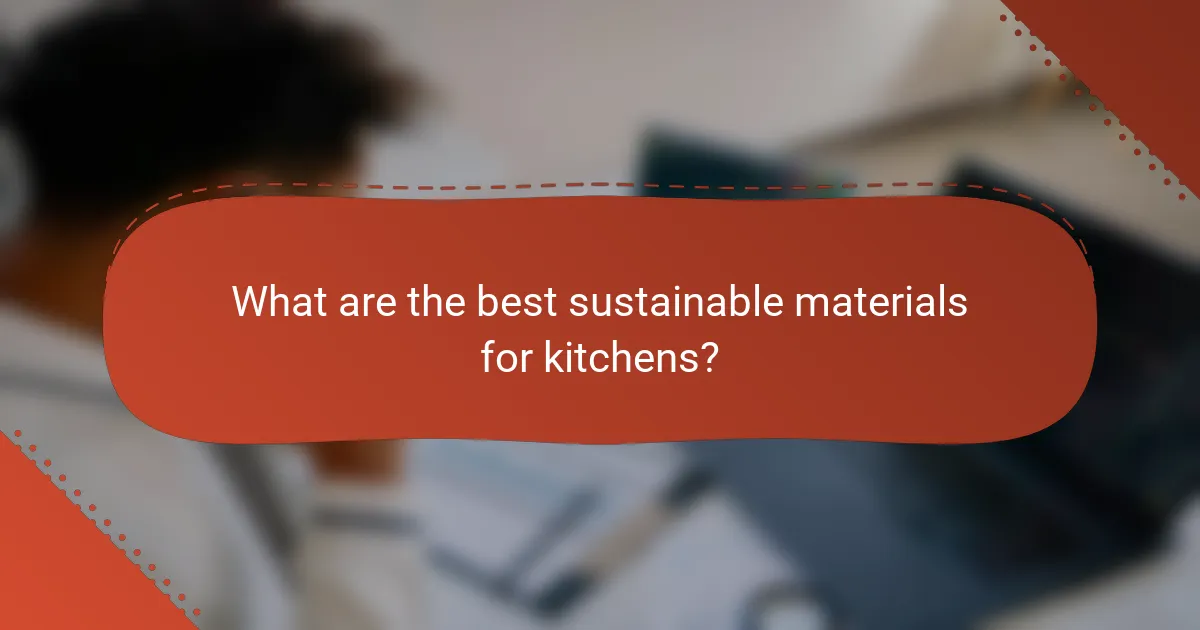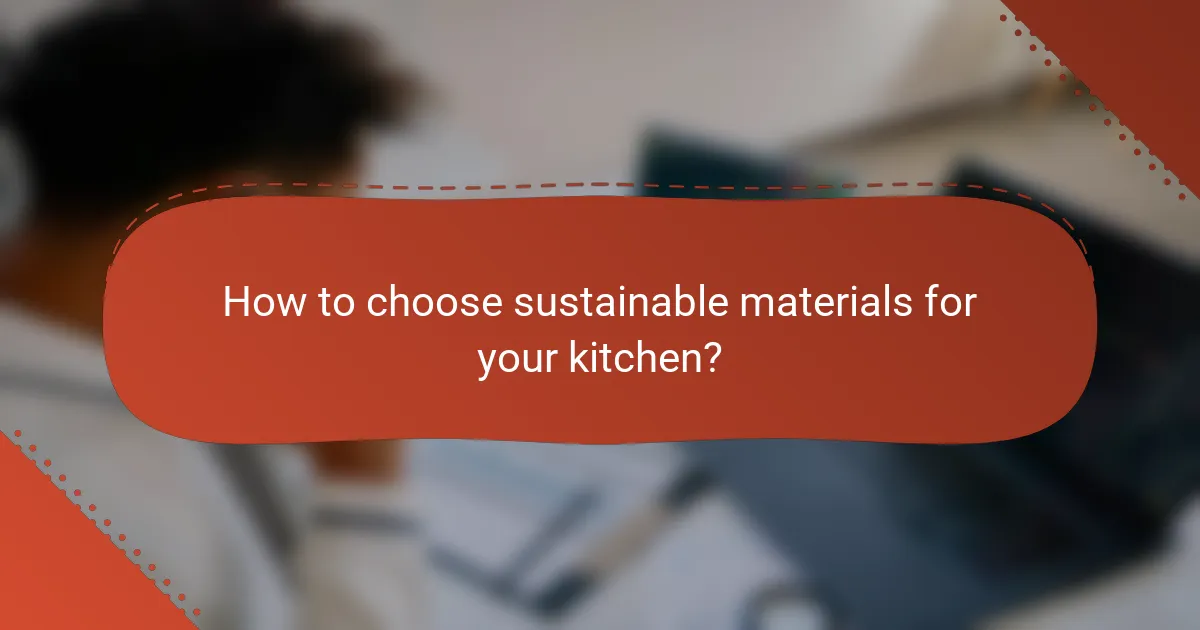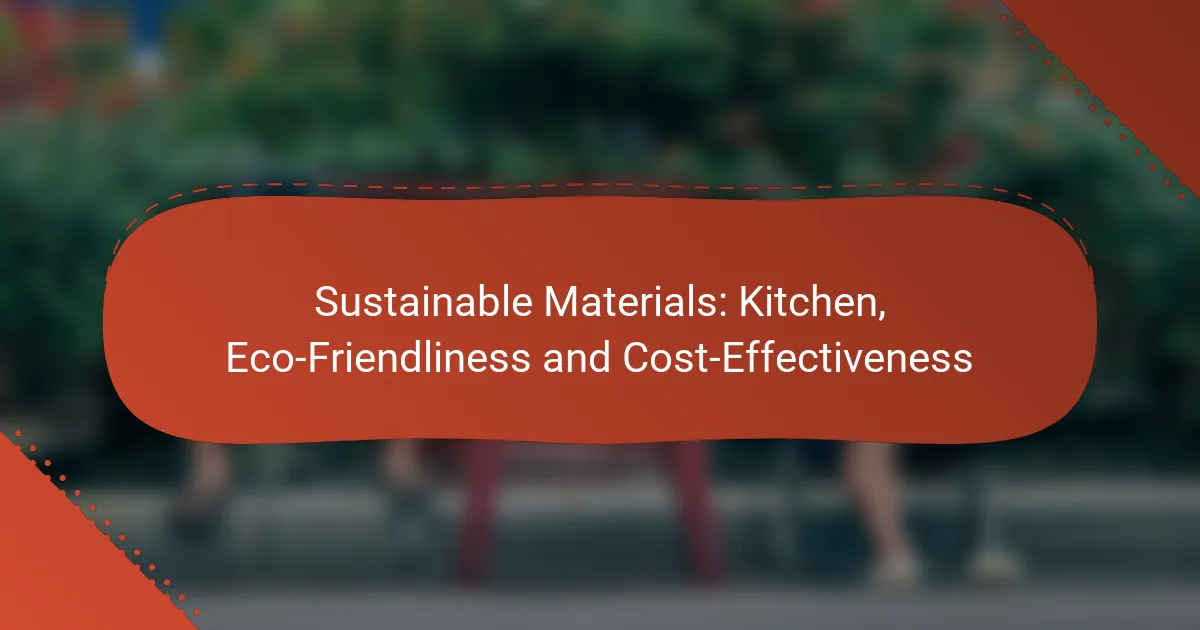Incorporating sustainable materials into your kitchen design not only promotes eco-friendliness but also offers cost-effective solutions for homeowners. Materials such as bamboo, recycled glass, and reclaimed wood provide durability and aesthetic appeal while minimizing environmental impact. By choosing these options, you can create a beautiful kitchen that aligns with sustainable practices and supports a healthier planet.

What are the best sustainable materials for kitchens?
The best sustainable materials for kitchens combine eco-friendliness with cost-effectiveness, ensuring a minimal environmental impact while remaining budget-conscious. Options like bamboo, recycled glass, cork, stainless steel, and reclaimed wood provide durability and aesthetic appeal while supporting sustainable practices.
Bamboo countertops
Bamboo countertops are a popular choice due to their rapid growth and renewability, making them an eco-friendly alternative to traditional hardwoods. They are typically harder than many hardwoods, providing durability and resistance to scratches and dents.
When considering bamboo, look for products that are certified by organizations like the Forest Stewardship Council (FSC) to ensure sustainable sourcing. Prices can vary, but bamboo countertops often range from moderate to slightly higher than laminate options, making them a cost-effective choice for many homeowners.
Recycled glass tiles
Recycled glass tiles offer a unique and colorful option for kitchen backsplashes and countertops, made from post-consumer glass waste. These tiles are not only visually appealing but also contribute to reducing landfill waste.
Installation can be more expensive than traditional ceramic tiles, but their durability and low maintenance can offset initial costs over time. Look for tiles that are certified for low VOC emissions to ensure a healthier indoor environment.
Cork flooring
Cork flooring is an excellent sustainable choice for kitchens, as it is harvested from the bark of cork oak trees without harming the tree itself. This material is naturally resistant to mold and mildew, making it ideal for areas prone to moisture.
While cork flooring can be more expensive upfront compared to vinyl or laminate, its longevity and comfort underfoot can provide long-term savings. Ensure you choose a product with a durable finish to protect against spills and wear.
Stainless steel appliances
Stainless steel appliances are not only sleek and modern but also highly durable and recyclable, making them a sustainable option for kitchens. They are resistant to rust and corrosion, which extends their lifespan significantly.
Investing in energy-efficient stainless steel appliances can lead to lower utility bills, as they often use less energy than older models. Look for the ENERGY STAR label to ensure you are choosing appliances that meet energy efficiency standards.
Reclaimed wood cabinets
Reclaimed wood cabinets are crafted from salvaged wood, giving a unique character to kitchens while reducing the demand for new lumber. This option is particularly appealing for those looking to incorporate rustic or vintage aesthetics into their design.
While the cost can vary widely based on the wood’s origin and condition, reclaimed wood often provides a one-of-a-kind look that new materials cannot replicate. Ensure that the wood is treated properly to prevent pests and decay, and consider finishes that are low in harmful chemicals.

How do sustainable materials contribute to eco-friendliness?
Sustainable materials play a crucial role in enhancing eco-friendliness by minimizing environmental impact throughout their lifecycle. They are sourced, produced, and disposed of in ways that reduce harm to the planet, making them a key choice for environmentally conscious consumers.
Reduced carbon footprint
Sustainable materials typically have a lower carbon footprint compared to conventional options. For instance, materials like bamboo and reclaimed wood require less energy to produce and transport, resulting in fewer greenhouse gas emissions. Choosing local materials can further decrease transportation emissions, contributing to a smaller overall carbon footprint.
When selecting materials for your kitchen, consider options certified by recognized standards, such as FSC (Forest Stewardship Council) for wood products, which ensures responsible sourcing and reduced environmental impact.
Lower energy consumption
Using sustainable materials often leads to lower energy consumption during both production and use. For example, energy-efficient appliances made from eco-friendly materials can significantly reduce electricity usage over their lifespan. Additionally, materials like recycled metal and glass generally require less energy to process than their virgin counterparts.
To maximize energy savings, look for Energy Star-rated appliances and fixtures that utilize sustainable materials, as these products are designed to operate efficiently while minimizing energy consumption.
Minimized waste production
Sustainable materials contribute to minimized waste production by promoting recycling and reusability. For instance, countertops made from recycled glass or composite materials can divert waste from landfills while providing durable surfaces for your kitchen. This approach not only reduces waste but also encourages a circular economy.
When planning your kitchen, consider incorporating modular designs that allow for easy upgrades or repairs, which can further reduce waste over time. Avoid single-use materials and opt for those that can be recycled or composted at the end of their life cycle.

What is the cost-effectiveness of sustainable kitchen materials?
Sustainable kitchen materials can be cost-effective over time due to their longevity and reduced maintenance needs. While the initial investment may be higher, the long-term savings and potential incentives can make them a financially sound choice.
Long-term savings
Investing in sustainable kitchen materials often leads to significant long-term savings. For example, energy-efficient appliances may have a higher upfront cost but can reduce utility bills by a notable percentage over their lifespan. Similarly, materials that require less frequent replacement, like bamboo or recycled metal, can lower overall renovation costs.
Consider calculating the total cost of ownership, which includes purchase price, maintenance, and energy costs. This approach helps in comparing sustainable options against traditional materials, revealing potential savings over time.
Durability and maintenance
Sustainable kitchen materials are typically designed for durability, which contributes to their cost-effectiveness. For instance, quartz countertops and reclaimed wood cabinets can withstand wear and tear better than cheaper alternatives, reducing the need for repairs or replacements.
Additionally, many eco-friendly materials require less maintenance, which saves both time and money. For example, finishes that resist stains and scratches minimize the need for frequent upkeep, allowing homeowners to allocate resources elsewhere.
Potential tax incentives
Homeowners may benefit from tax incentives when they choose sustainable kitchen materials. In various regions, including the U.S. and parts of Europe, government programs offer rebates or tax credits for energy-efficient appliances and renewable materials.
It’s advisable to research local regulations and incentives, as they can vary significantly. Consulting with a tax professional can help identify available benefits, making sustainable choices even more financially attractive.

How to choose sustainable materials for your kitchen?
Choosing sustainable materials for your kitchen involves evaluating their environmental impact, cost-effectiveness, and local availability. Prioritize options that minimize ecological harm while fitting within your budget and sourcing capabilities.
Assessing environmental impact
To assess the environmental impact of kitchen materials, consider their lifecycle from production to disposal. Look for certifications such as FSC for wood or Energy Star for appliances, which indicate adherence to sustainability standards.
Materials like bamboo and recycled metal are often more eco-friendly than traditional options. Evaluate the carbon footprint associated with transportation, as locally sourced materials typically have lower emissions.
Evaluating cost vs. benefit
When evaluating cost versus benefit, weigh the initial investment against long-term savings and durability. Sustainable materials may have higher upfront costs but can lead to lower energy bills and reduced maintenance expenses over time.
For example, energy-efficient appliances may cost more initially but can save hundreds of dollars annually on utility bills. Consider the total cost of ownership rather than just the purchase price.
Considering local availability
Local availability plays a crucial role in selecting sustainable materials for your kitchen. Sourcing materials from nearby suppliers can reduce transportation emissions and support the local economy.
Research local markets for sustainable options, such as reclaimed wood or locally manufactured countertops. This not only helps in minimizing your carbon footprint but may also offer unique, region-specific designs.

What are the trends in sustainable kitchen materials in major cities?
Major cities are increasingly adopting sustainable kitchen materials, driven by consumer awareness and environmental regulations. Trends include the use of recycled, renewable, and locally sourced materials that minimize environmental impact while enhancing aesthetic appeal.
Growing demand for eco-friendly products
The demand for eco-friendly kitchen products is rising as consumers prioritize sustainability in their purchasing decisions. This shift is evident in the popularity of materials like bamboo, reclaimed wood, and recycled metal, which are both stylish and environmentally responsible.
Homeowners are also looking for certifications that indicate sustainability, such as Forest Stewardship Council (FSC) for wood products or Energy Star ratings for appliances. These certifications help consumers make informed choices that align with their eco-friendly values.
To meet this demand, manufacturers are innovating with new materials and production methods. For example, countertops made from recycled glass or composite materials are gaining traction, offering durability and a lower carbon footprint compared to traditional options.
